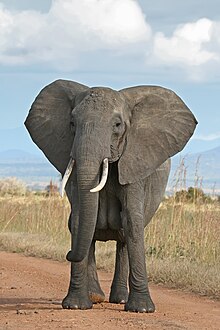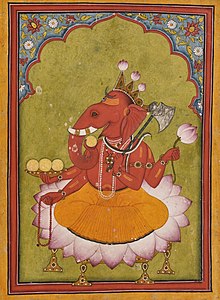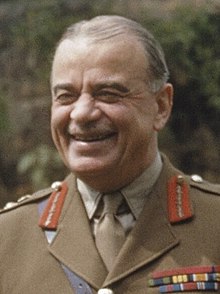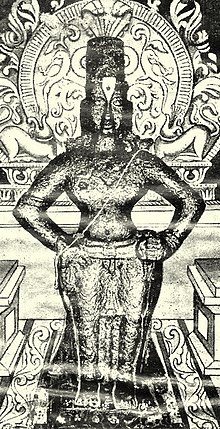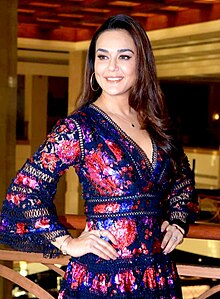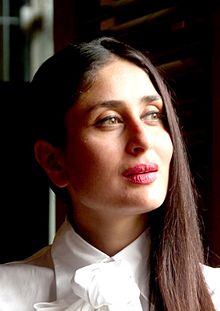Introduction

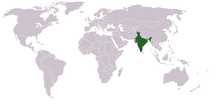
India, officially the Republic of India (ISO: Bhārat Gaṇarājya), is a country in South Asia. It is the seventh-largest country by area; the most populous country as of June 2023; and from the time of its independence in 1947, the world's most populous democracy. Bounded by the Indian Ocean on the south, the Arabian Sea on the southwest, and the Bay of Bengal on the southeast, it shares land borders with Pakistan to the west; China, Nepal, and Bhutan to the north; and Bangladesh and Myanmar to the east. In the Indian Ocean, India is in the vicinity of Sri Lanka and the Maldives; its Andaman and Nicobar Islands share a maritime border with Thailand, Myanmar, and Indonesia. (Full article...)
Selected pictures
Mansukhani conceived the film as a tale of 3 friends living together, drawing inspiration by his own experience. Wanting to add something different to the script, he later decided to introduce homosexuality, which he thought was unexplored by Indian films, to shed light on the issue for the Indian audience. Manish Malhotra designed Chopra's costumes, and Aki Narula designed costumes for the rest of the cast. The soundtrack was composed by Vishal–Shekhar; Kumaar and Vishal Dadlani wrote its lyrics, while Salim–Sulaiman composed the background score. Principal photography took place in Miami, Florida over a two-month period in the first half of 2008. Dostana was the first mainstream Indian film with a gay element and has been credited for exploring a topic largely ignored by Hindi cinema. (Full article...)
Following protests by the queer community against the 2016 and 2018 bills, the 2019 act has done away with few of the severely criticised provisions of the 2018 bill, such as the criminalisation of begging and the establishment of a district screening committee to process applications for issuance of transgender person certificates. However, it fails to incorporate yet other principles in line with the Supreme Court judgment in National Legal Services Authority v. Union of India (NALSA v. UOI) in 2014, such as the right of transgender people to declare their self-perceived gender identity without undergoing sex reassignment surgery, and reservations in jobs and educational institutions. The act has also been criticised for imposing less punishment for crimes against transgender people compared with punishment for crimes against cisgender people. On 27 January 2020, the Supreme Court issued a notice to the central government in a petition challenging the constitutionality of the act. (Full article...)
Filming began on 27 August 2012 in Mumbai, with filming moving to Oman in September, becoming the first major Indian production filmed in the sultanate. Footage was shot in beach in Qantab, Qurum, and at the Shangri-La's Barr Al Jissah Resort & Spa in Muscat. The film's visual effects (VFX) were by Reliance MediaWorks, and a team of 40 artists augmented 600 digital shots in one month. The live action sequences were filmed with RED and Arri's Alexa digital motion-picture camera. Once Upon ay Time in Mumbai Dobaara! was well-promoted, and the film's second trailer was shown on prime-time slots on four television channels. Hollywood actor Al Pacino was shown the theatrical trailer of the film. (Full article...)

Divya Bharti (Hindi pronunciation: [dɪʋjaː bʱaːrtiː]; 25 February 1974 – 5 April 1993) was an Indian actress who worked predominantly in Telugu and Hindi films. One of India's highest-paid actresses of her time, she was noted for her acting versatility and beauty, and is the recipient of a Filmfare Award and a Nandi Award.
Bharti started her film career as a teenager, while she was doing pin-up modeling assignments. She made her debut with a lead role opposite Venkatesh in the Telugu-language romantic action Bobbili Raja (1990), and subsequently appeared in a financially unsuccessful Tamil-language film Nila Pennae (1990). In films like Naa Ille Naa Swargam (1991) and Assembly Rowdy (1991) she had minor roles. Bharti had her first commercial success with the Telugu romantic comedy Rowdy Alludu (1991). (Full article...)
Shot primarily in New Delhi, Rang De Basanti was released globally on 26 January 2006. Upon release, the film broke all opening box office records in India, becoming the country's highest-grossing film in its opening weekend and holding the highest opening-day collections for a Hindi film. It received critical acclaim, winning the National Film Award for Best Popular Film, and being nominated for Best Foreign Language Film at the 2007 BAFTA Awards. The film was chosen as India's official entry for the Golden Globe Awards and the Academy Awards in the Best Foreign Language Film category, though it did not ultimately yield a nomination for either award. A. R. Rahman's soundtrack, which earned positive reviews, had two of its tracks considered for an Academy Award nomination. (Full article...)

Ross Island Penal Colony was a convict settlement that was established in 1858 in the remote Andaman Islands by the British colonial government in India, primarily to jail a large number of prisoners from the Indian Rebellion of 1857, also known as the Indian Mutiny. With the establishment of the penal colony at Ross Island, the British administration made it the administrative headquarters for the entire group of Andaman and Nicobar Islands and built bungalows and other facilities on the site. This colony was meant as "manageable models of colonial governance and rehabilitation". The Chief Commissioner's residence was located at the highest point on the island. Over time, several other islands including Chatham and Viper were used for the penal colony.
The penal colony became infamous as "Kalapani" or "black water" for the brutalities inflicted by the British authorities on the political prisoners from India, and most of whom had died by 1860 due to illness and torture suffered during the initial stages of the clearance of the forest to establish the colony. In later years the colony experimented for a short time with civilizing the indigenous people of Andamans. The penal colony was used as an experimental station for various methods of torture and medical tests During World War II, the island was invaded by the Japanese army, forcing the British to evacuate. The administrative buildings were destroyed but the penal colony remained. After the Allied forces reoccupied the island the penal colony was disbanded on 7 October 1945. (Full article...)
Known variously in his cricket career as "Kumar Narayan" or "Hitendra Narayan", he was educated at Eton College and Cambridge University and was a forceful right-handed batsman. His four first-class matches for Somerset in 1909 and 1910 were not successful, with a top score of just 16 in his first game, against the 1909 Australians. In 1918, he played three matches for his brother's scratch side against teams composed largely of expatriate Englishmen. The matches have first-class status although all three were of only two-days' duration; Narayan was not successful in any of them as a batsman. (Full article...)
The film opened to Indian audiences on 9 August 2006. On its way to winning state honours and rave reviews, the film went on to win several Filmfare Awards among other prominent awards and was one of the highest grossing Telugu films of that year. Following the film's box office success, it was remade in Tamil as Santosh Subramaniam (2008), in Bengali as Bhalobasa Bhalobasa (2008), in Odia as Dream Girl (2009), and in Hindi as It's My Life (2020). (Full article...)
Development of the film began in 2015, when Shinde signed Bhatt and Khan for a film to be made under her banner. Principal photography took place in Goa and Mumbai, in the period from 21 January to 20 May 2016. The film features a score composed by Amit Trivedi and lyrics written mostly by Kausar Munir. (Full article...)

The Alchon Huns, (Bactrian: αλχον(ν)ο Alkhon(n)o or αλχαν(ν)ο Alkhan(n)o) also known as the Alkhan, Alchono, Alxon, Alkhon, Alakhana, and Walxon, were a nomadic people who established states in Central Asia and South Asia during the 4th and 6th centuries CE. They were first mentioned as being located in Paropamisus, and later expanded south-east, into the Punjab and Central India, as far as Eran and Kausambi. The Alchon invasion of the Indian subcontinent eradicated the Kidarite Huns who had preceded them by about a century, and contributed to the fall of the Gupta Empire, in a sense bringing an end to Classical India.
The invasion of India by the Huna peoples follows invasions of the subcontinent in the preceding centuries by the Yavana (Indo-Greeks), the Saka (Indo-Scythians), the Pahlava (Indo-Parthians), and the Kushana (Yuezhi). The Alchon Empire was the second of four major Huna states established in Central and South Asia. The Alchon were preceded by the Kidarites and succeeded by the Hephthalites in Bactria and the Nezak Huns in the Hindu Kush. The names of the Alchon kings are known from their extensive coinage, Buddhist accounts, and a number of commemorative inscriptions throughout the Indian subcontinent. (Full article...)
The Shaheen Bagh protest was a peaceful sit-in protest in Delhi, India, that began on 15 December 2019 and lasted until 24 March 2020. The protest was led by women who blocked a major road at Shaheen Bagh using non-violent resistance 24×7. Mainly consisting of Muslim women, the protest began in response to the passage of the Citizenship (Amendment) Act (CAA) on 11 December 2019 and the ensuing police intervention against students at Jamia Millia Islamia who were opposing the Amendment. Protesters agitated against the citizenship issues of the CAA, National Register of Citizens (NRC) and National Population Register (NPR), in addition to police brutality, unemployment, and poverty, and for women's safety. The Delhi Police barricaded major roads in and around the area, affecting more than 100,000 vehicles a day and adding hours to some journeys. Following the North East Delhi riots, police presence in the area temporarily increased with over 1000 personnel being assigned to Shaheen Bagh. After the COVID-19 outbreak in India and subsequent government-enforced restrictions the protest continued for several days in a more controlled manner. Following the complete lockdown imposed in Delhi on 23 March 2020, the remaining protesters were arrested or forcefully removed from the site by the Delhi Police.
The barricaded and tented venue drew large crowds with tens of thousands of protesters participating. Some days saw over 150,000 at the venue. The protest inspired similar copycat protests across the country, such as those in Gaya, Kolkata, Prayagraj, Mumbai and Bengaluru. The leaderless protest became politicized and was generally against the Bharatiya Janata Party (BJP) government. The blockade became a campaign issue in the 2020 Delhi Legislative Assembly elections, especially for the BJP. BJP's campaign was negative towards the Shaheen Bagh protests with a number of campaigners making controversial statements such as "goli maaro" (English: Shoot them). Some BJP campaigners promised to immediately remove the blockade after being voted into power and were accused by their opponents of prolonging the demonstration to agitate voters. BJP won an extra six seats as compared to the last election while Aam Aadmi Party retained a clear majority with 62 seats. (Full article...)
In 1983, Neila was appointed the dance instructor and choreographer for the Indian Dance Group of the People's Association (PA)—a state board in Singapore—where she remained a resident choreographer. She was also an artistic adviser to Singapore's National Arts Council. For her contributions to dance, Neila was awarded the Singaporean Cultural Medallion in 1989. She became a Singapore citizen in 1994. (Full article...)
The 1990 Andhra Pradesh cyclone was the worst disaster to affect Southern India since the 1977 Andhra Pradesh cyclone. The system was first noted as a depression on 4 May 1990, while it was located over the Bay of Bengal about 600 km (375 mi) to the southeast of Chennai, India. During the next day the depression intensified into a cyclonic storm and started to intensify rapidly, becoming a super cyclonic storm early on 8 May. The cyclone weakened slightly before it made landfall on India about 300 km (190 mi) to the north of Madras in the Andhra Pradesh state as a very severe cyclonic storm with winds of 165 km/h (105 mph). While over land the cyclone gradually dissipated. The cyclone had a severe impact on India, with over 967 people reported to have been killed. Over 100,000 animals also died in the cyclone with the total cost of damages to crops estimated at over $600 million (1990 USD). (Full article...)
The film's development began when Ratnam began writing a short story tiled "Divya" with no cinematic plans until he finished it. Since production on his directorial debut Pallavi Anu Pallavi (1983) was delayed, he took a break for a month and developed "Divya" into a film script, which would eventually be renamed Mouna Ragam. Although Ratnam began work on the script during Pallavi Anu Pallavi, it languished in development hell and ended up becoming his fifth film. Mouna Ragam was the first film produced by Venkateswaran's Sujatha Films, and was shot primarily in Madras, with additional filming taking place in Delhi and Agra. The music was composed by Ilaiyaraaja, with lyrics by Vaali. P. C. Sreeram was the cinematographer, and the art director was Thota Tharani. The film was edited by B. Lenin and V. T. Vijayan. (Full article...)
The core plot was partially inspired by John Woo's 1997 American film Face/Off, and revolves around two strangers, Satya and Charan. The film was made on a budget of ₹35 crore, and was officially launched on 9 December 2011. Principal photography began on 27 April 2012 and lasted until 22 July 2013. The majority of the film was shot in Visakhapatnam and Hyderabad, mostly in Ramoji Film City, while two songs were shot in Switzerland and Bangkok. (Full article...)
The history of present-day Indian gallantry awards can be traced back to the rule of the East India Company, when the first formal award was instituted by Lord William Bentinck in 1834 as the Order of Merit, later renamed the Indian Order of Merit in 1902. During the First World War, the British awards system was adopted and continued through the Second World War. Post-independence, new awards were instituted on 26 January 1950, with retroactive effect from 15 August 1947. The PVC is equivalent to the Victoria Cross in the United Kingdom and the Medal of Honor in the United States. (Full article...)

Sallekhana (IAST: sallekhanā), also known as samlehna, santhara, samadhi-marana or sanyasana-marana, is a supplementary vow to the ethical code of conduct of Jainism. It is the religious practice of voluntarily fasting to death by gradually reducing the intake of food and liquids. It is viewed in Jainism as the thinning of human passions and the body, and another means of destroying rebirth-influencing karma by withdrawing all physical and mental activities. It is not considered a suicide by Jain scholars because it is not an act of passion, nor does it employ poisons or weapons. After the sallekhana vow, the ritual preparation and practice can extend into years.
Sallekhana is a vow available to both Jain ascetics and householders. Historic evidence such as nishidhi engravings suggest sallekhana was observed by both men and women, including queens, in Jain history. However, in the modern era, death through sallekhana has been a relatively uncommon event. (Full article...)

Ayudhapurusha is the anthropomorphic depiction of a divine weapon in Hindu art. Ayudhapurushas are sometimes considered as partial incarnates of their divine owners.
The sex of the personified weapon is determined by the gender of the weapon in the Sanskrit language. The suffix "purusha" (man) is added to masculine weapons and "devi" (goddess) to female ones. The weapons Shakti, Heti (a Hatchet-like weapon) and Gada (mace), especially Kaumodaki (the mace of Vishnu), Dhanus/Dhanushya ("bow") are women. Chakra, especially Vishnu's Sudarshana Chakra (discus of Vishnu), Shankha ("conch"), Padma (lotus), Ankusha (elephant goad), Pasha (noose), Trisula (trident), vajra (thunderbolt), Khadga (sword), Danda (a sceptre or club), Bana/Shara ("arrow") and Bhindi (sling) are depicted male. (Full article...)
The purple heron (Ardea purpurea) is a wide-ranging heron species. It breeds in Africa, central and southern Europe, and southern and eastern Palearctic. The Western Palearctic populations migrate between breeding and wintering habitats whereas the African and tropical-Asian populations are primarily sedentary, except for occasional dispersive movements.
It is similar in appearance to the more common grey heron but is slightly smaller, more slender and has darker plumage. It is also a more evasive bird, favouring densely vegetated habitats near water, particularly reed beds. It hunts for a range of prey including fish, rodents, frogs and insects, either stalking them or standing waiting in ambush. (Full article...)
News
- 9 June 2024 – Insurgency in Jammu and Kashmir
- At least nine people are killed and 33 others are injured near Reasi, Jammu and Kashmir, India, when a bus carrying Hindu pilgrims falls into a ravine after being shot at. (Al Jazeera)
- 9 June 2024 – 2024 Indian general election
- Narendra Modi is sworn in for his third term as Prime Minister of India. (Al Jazeera)
- 6 June 2024 – 2024 Uttarakhand snowstorm disaster
- A blizzard in the Himalaya mountains of Uttarakhand, India, kills nine Indian trekkers. (Reuters)
- 6 June 2024 –
- SpaceX launches Starship's Integrated Flight Test 4, successfully guiding both the Super Heavy booster and Starship upper stage to soft water landings in the Gulf of Mexico and the Indian Ocean, respectively. (The New York Times)
- 4 June 2024 – 2024 Indian general election
- The alliance of parties led by Narendra Modi reaches the 272 seats threshold needed to form a government, but Modi's BJP party loses its outright parliamentary majority. (BBC News)
Did you know...
- ... that Indian gynaecologist and reproductive medicine pioneer Baidyanath Chakrabarty, who performed over 4,000 IVF procedures, was a cricket fan who thought Virat Kohli and Ashwin were "such good boys"?
- ... that the Clock Tower of Haridwar in India provides a good location from which to watch the evening prayers at Har Ki Pauri?
- ... that the 19-year-old Maharaja Bhupinder Singh of Patiala was the captain of the first all-Indian cricket team to tour England in 1911?
- ... that Zakir Husain was the first Muslim and the first governor of a state to be elected President of India?
- ... that Indian singer Sudakshina Sarma sang in Assamese as Mahatma Gandhi's ashes were immersed in the Brahmaputra River?
- ... that Indian Army havildar Naren Chandra Das escorted the 14th Dalai Lama to safety in India after the monk made a 13-day trek across the Himalayas dressed as a soldier to evade Chinese troops?
Timeline of Indian history, Indus Valley Civilisation, Dholavira, Science and technology in ancient India, Meluhha, Aryan invasion theory, Out of India theory, Greek conquests in India, Indian maritime history, Maurya Empire, Ashoka, Shunga Empire, Hoysala Empire, Vijayanagara, Satavahana dynasty, Indo-Greek Kingdom, Indo-Scythians, Indo-Parthian Kingdom, Kushan Empire, Western Satraps, Gupta Empire, Chola dynasty, Pala Empire, Islamic incursions in India, Mughal Empire, Maratha Empire, British Raj, East India Company, Governor-General, Viceroy, War of Independence, 1857, Indian independence movement, Indian National Army, Azad Hind, Quit India Movement, Partition of India, History of Republic of India, Non-Aligned Movement, Sino-Indian War, Indo-Pakistani War of 1947–1948, Indo-Pakistani War of 1965, Indo-Pakistani War of 1971, Kargil War, 2001–02 India–Pakistan standoff, Military, Demographic
Law, Hindu law, Constitution, Political parties (Indian National Congress, Bharatiya Janata Party), Foreign relations, Elections, Political divisions, Reservation in India
Government agencies, Legislative branch (Lok Sabha, Rajya Sabha) Executive branch (President & Vice President, Prime Minister & Deputy Prime Minister, Cabinet Ministers, Cabinet Secretary, Election Commission, Foreign Minister; Law enforcement: CBI, CID, Intelligence: IB, RAW), Directorate General of Income Tax Investigation Judicial branch (Supreme Court), Armed Forces (Army, Navy, Air Force, Border Security Force, Coast Guard)
Himalayas, Western Ghats, Eastern Ghats, Indo-Gangetic Plain, Deccan Plateau, Thar Desert, Ganges, Rann of Kutch, Brahmaputra River, Northeast India; Mountains, Valleys, Islands, Rivers; States and union territories, Cities, Districts, Regions, Fauna, Flora
Rupee, Bombay Stock Exchange, National Stock Exchange, Standard of living, Companies, Reserve Bank of India, Energy policy (Solar, Wind, Nuclear), Tourism, Transport (Expressways, Rail transport, Auto rickshaw),
Languages, Standard of living, Religion
Music (Carnatic, Hindustani, Indi-pop), Dance, Languages, Literature, Architecture, Film & TV, Cuisine, Holidays, Folklore, Education, Media, Indian martial arts
Indian Council of Agricultural Research (ICAR), Indian Institute of Astrophysics, National Centre for Software Technology, AIIMS, IISc, IIT, NIT, BITS-Pilani, INRegistry, Indian numbering system, Indian Space Research Organisation, National Internet Exchange of India, ICRISAT, International Institute of Information Technology, Hyderabad
Indian English, Indian nationality law, Numbering system, Indian Space Research Organisation, Telecommunications, National Highways Development Project, Flag, Vehicle registration plates, Indian nationalism, Metrication in India
Categories
Related portals
Religions in India
Indian Subcontinent
Other countries
Wikipedias in Indian languages
- অসমীয়া (Assamese)
- বাংলা (Bengali)
- भोजपुरी (Bhojpuri)
- বিষ্ণুপ্রিয়া মণিপুরী (Bishnupriya Manipuri)
- गोंयची कोंकणी / Gõychi Konknni (Konkani)
- ગુજરાતી (Gujarati)
- हिन्दी (Hindi)
- ಕನ್ನಡ (Kannada)
- कॉशुर/كشميري (Kashmiri)
- मैथिली (Maithili)
- മലയാളം (Malayalam)
- मराठी (Marathi)
- नेपाली (Nepali)
- नेपाल भाषा
- (Newari)
- ଓଡ଼ିଆ (Odiya)
- ਪੰਜਾਬੀ (Punjabi)
- पालि (Pali)
- संस्कृत (Sanskrit)
- ᱥᱟᱱᱛᱟᱲᱤ (Santali)
- سنڌي (Sindhi)
- தமிழ் (Tamil)
- తెలుగు (Telugu)
- ತುಳು (Tulu)
- اردو (Urdu)
Associated Wikimedia
The following Wikimedia Foundation sister projects provide more on this subject:
-
Commons
Free media repository -
Wikibooks
Free textbooks and manuals -
Wikidata
Free knowledge base -
Wikinews
Free-content news -
Wikiquote
Collection of quotations -
Wikisource
Free-content library -
Wikiversity
Free learning tools -
Wikivoyage
Free travel guide -
Wiktionary
Dictionary and thesaurus

![Image 1 Kahaani (IPA: [kəˈɦaːni]; transl. Story) is a 2012 Indian Hindi-language thriller film co-written, co-produced, and directed by Sujoy Ghosh. It stars Vidya Balan as Vidya Bagchi, a pregnant woman looking for her missing husband in Kolkata during the festival of Durga Puja, assisted by Assist Sub-Inspector Satyoki "Rana" Sinha (Parambrata Chatterjee) and Inspector General A. Khan (Nawazuddin Siddiqui). Made on a shoestring budget of ₹80 million (US$960,000), Kahaani was conceived and developed by Ghosh, who co-wrote the film with Advaita Kala. The crew often employed guerrilla-filmmaking techniques on Kolkata's city streets to avoid attracting attention. Its creative portrayal of the city and its use of local crew and cast members made it a notable film. Kahaani explores themes of feminism and motherhood in a male-dominated Indian society. The film also makes several allusions to Satyajit Ray's films, such as Charulata (1964), Aranyer Din Ratri (1970), and Joi Baba Felunath (1979). The film's musical score and soundtrack are composed by Clinton Cerejo and Vishal–Shekhar respectively, with cinematography handled by Setu and editing done by Namrata Rao. (Full article...)](http://upload.wikimedia.org/wikipedia/en/d/d2/Blank.png)


